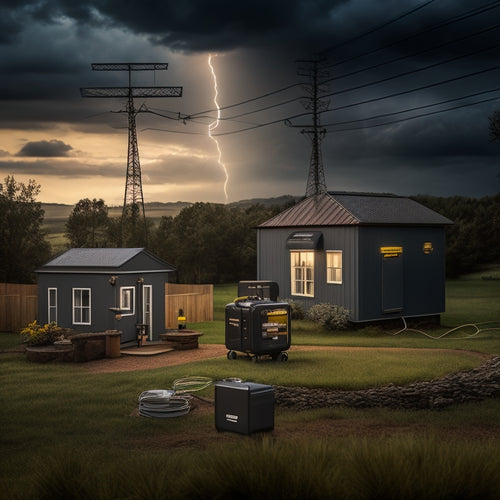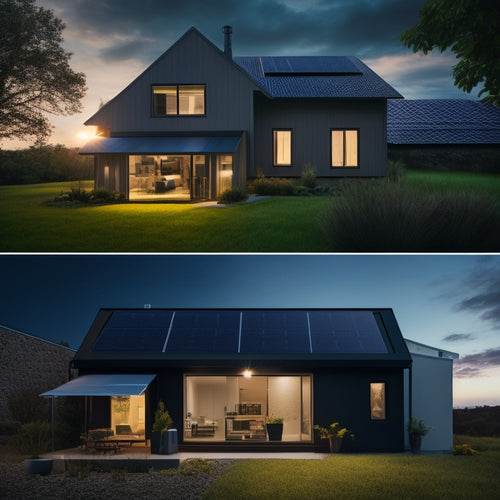
Why Clean Solar Panels After Snowfall?
Share
You can lose up to 90% of your solar panel's energy production if you don't clean them after snowfall, making regular cleaning essential to maintaining peak energy output during the winter months. Even a small amount of snow, just 1-2 inches, can reduce energy production by 20-30%. Cleaning your panels after snowfall can lead to a significant increase in energy generation, as removal of snow's insulating layer allows clean panels to operate at their ideal temperature. By doing so, you'll not only maximize your energy output but also uncover more ways to guarantee your solar panels perform at their best.
At a Glance
- Cleaning solar panels after snowfall restores energy production, as snow accumulation can reduce output by up to 90%.
- Removing snow's insulating layer allows panels to operate at an ideal temperature, enhancing efficiency and energy generation.
- Clean panels can produce up to 25% more energy than dirty ones, maximizing return on investment and independent energy generation.
- Regular cleaning post-snowfall prevents micro-cracks, extends lifespan, and reduces repair needs, ensuring peak performance.
- Snow-repellent coatings and micro-textures promote easier maintenance, consistent energy production, and long-term solar panel effectiveness.
Maximize Winter Energy Output
You can't afford to let winter weather reduce your solar panel's energy output. Snowfall can lead to significant winter energy loss, and you'll want to minimize it to guarantee you're generating power at peak levels.
By integrating a battery storage system into your solar setup, you can unlock the full potential of renewable energy and create a more sustainable, dependable, and cost-effective power solution, even during winter months.
Winter Energy Loss
During winter, solar panels are prone to considerable energy loss due to snow accumulation, which can lead to a substantial decline in energy output. You might be surprised to know that even a thin layer of snow can reduce your solar panel's energy production by up to 50%.
This energy loss can be devastating, especially when you rely on your solar panels to power your home or business. Many homeowners and businesses opt for off-grid solar power systems to achieve energy independence, but it's vital to maintain these systems to maximize their efficiency renewable energy solutions.
By doing so, you can facilitate a seamless shift to off-grid energy independence. To mitigate this energy loss, you need to prioritize solar panel maintenance. Implementing energy conservation strategies, such as regular cleaning and inspections, can help minimize the impact of snow on your solar panels.
By removing snow and debris, you can guarantee your solar panels operate at peak levels, even during the harsh winter months. It's important to develop a maintenance routine that includes snow removal, as it can greatly improve your solar panel's performance and energy output.
Snowy Panel Efficiency
Snow-covered solar panels greatly impede energy production, making it vital to prioritize cleaning and maintenance to enhance winter energy output. You invest in solar panels to generate clean energy and reduce your reliance on the grid, but snow accumulation can hinder that goal.
| Snow Coverage | Energy Production | Panel Visibility |
|---|---|---|
| 1-2 inches | 20-30% reduction | Partially visible |
| 2-4 inches | 40-50% reduction | Barely visible |
| 4-6 inches | 60-70% reduction | Not visible |
| 6+ inches | 80-90% reduction | Completely hidden |
As shown in the table, even a small amount of snow can considerably reduce energy production. When snow covers your panels, it blocks sunlight, decreasing panel visibility and, subsequently, energy output. By cleaning your solar panels regularly, especially after snowfall, you can guarantee peak energy production and maintain your independence from the grid. Don't let snow accumulation hold you back from utilizing the full potential of your solar panels – prioritize cleaning and maintenance to maximize your winter energy output.
Boosts Energy Output Up
By cleaning your solar panels after snowfall, you can experience a significant energy generation increase, especially for homeowners invested in renewable energy systems and committed to creating eco-friendly homes.
In fact, efficient and durable house solar panels require regular maintenance to optimize their performance. This is because snow-covered panels can reduce energy output by up to 90%, and cleaning them allows you to regain maximum power output.
As a result, you'll produce more electricity and get the most out of your solar investment.
Energy Generation Increase
As solar panels begin to thaw out after a snowfall, you'll notice a significant uptick in energy generation. This increase is due to the removal of snow's insulating layer, which blocked sunlight and reduced solar efficiency.
With the panels now clear, they can utilize the sun's energy more effectively, resulting in an enhancement to your energy output.
The snow's departure also means your solar panels can operate at their ideal temperature, around 59°F (15°C). This perfect temperature range improves energy conservation, as the panels can convert sunlight into electricity more efficiently.
In addition, a clean panel surface allows for better heat dissipation, reducing the risk of overheating and subsequent energy losses.
Maximum Power Output
You'll experience a significant increase in maximum power output once your solar panels are free of snow. This enhancement in energy production is a direct result of effective solar panel maintenance.
When snow covers your panels, it blocks sunlight from reaching the photovoltaic cells, reducing their ability to generate electricity. By removing snow and debris, you're allowing your panels to operate at peak performance.
A clean solar panel can produce up to 25% more energy than a dirty one. This increase in maximum power output translates to more electricity for your home or business, reducing your reliance on the grid and saving you money on your energy bills.
Regular cleaning is vital to maintaining peak performance and maximizing your return on investment. By prioritizing solar panel maintenance, you're ensuring your system operates at its full potential, giving you the freedom to generate your own clean energy and live life on your own terms.
Snow-Repellent Coatings Matter
You'll find that snow-repellent coatings can markedly reduce ice adhesion on your solar panels, allowing snow to slide off more easily.
By applying a hydrophobic surface treatment, you'll create a barrier that prevents water from spreading and forming ice, which in turn reduces the weight and stress on your panels.
In addition, integrating smart battery storage solutions, such as Tesla Powerwall, can further enhance the performance of your solar panel system.
This coating can be especially beneficial in areas with frequent snowfall, where heavy snow loads can compromise your system's performance.
Coatings Reduce Ice Adhesion
Snow-repellent coatings play an essential role in reducing ice adhesion on solar panels, allowing for easier snow removal and minimizing the impact of snowfall on energy production.
When you apply a snow-repellent coating to your solar panels, you're taking a vital step towards preventing ice buildup and ensuring maximum energy efficiency.
These coatings work by reducing the surface tension of the panel, making it more difficult for ice to form and adhere.
This means you'll spend less time and effort removing snow, and your solar panels will be able to generate power more consistently.
Hydrophobic Surface Benefits
When snow hits your solar panels, every minute counts in getting them back online, and a hydrophobic surface can be the difference-maker.
With hydrophobic technology, you can reduce the time and effort spent on cleaning your solar panels after snowfall. This technology creates a surface that's extremely difficult for water and snow to bond with, allowing snow to slide right off.
The surface characteristics of hydrophobic coatings make them ideal for solar panels.
The coatings create a nano-scale roughness that reduces the contact angle between the surface and snow, making it easier for snow to slide off.
This means you'll spend less time and money on cleaning and maintenance, and more time generating clean energy.
Micro-Texture Enhances Water Shedding
You'll find that micro-textured surfaces can enhance the snow-repellent properties of your solar panels, allowing snow to slide off more easily.
By incorporating energy storage technologies into your solar power system, you can guarantee a steady supply of energy even during periods of low sunlight.
This is because the micro-texture creates a snow-repellent surface that reduces the contact area between the snow and the panel, enabling the snow to release more efficiently.
As a result, you'll see gains in water-beading efficiency, which helps to minimize the impact of snowfall on your solar panel's performance.
Snow-Repellent Surface Boost
As solar panels are designed to maximize energy output, manufacturers have been working to create surfaces that can effectively shed snow and water.
You'll benefit from surfaces with micro-textures that enhance water shedding, reducing snow accumulation and increasing surface durability. These textures create a snow-repellent surface enhancement, allowing snow to slide off easily and minimizing the impact of snowfall on your solar panel's performance.
When snow accumulates on your solar panels, it can reduce energy output by up to 90%. By incorporating micro-textures, you can minimize this loss and guarantee your panels operate at peak levels.
The micro-textures work by creating a layer of air between the snow and the panel's surface, allowing the snow to slide off easily. This reduces the force of snow accumulation, protecting the surface from damage and maintaining its durability.
With a snow-repellent surface enhancement, you can enjoy uninterrupted energy production, even during harsh winter conditions.
This innovation is a transformative development for those who rely on solar power, providing the freedom to generate energy without interruptions.
Water-Beading Efficiency Gains
Snowfall's aftermath often leaves solar panels wrestling with water accumulation, a silent energy-sapping culprit. When water droplets form on your panels, they can reduce energy output by up to 25%. You can't afford to let this happen, especially when you've invested in clean energy for freedom from utility bills.
Micro-textures on your solar panels can greatly enhance water shedding. This means you'll experience improved water runoff, reducing the need for frequent panel cleaning. By allowing water to bead up and roll off, micro-textures create a self-cleaning effect. This innovative technology increases your solar panel's efficiency gains, ensuring you maximize your energy harvest.
In snowy climates, this feature is particularly essential. By shedding water quickly, your panels will remain energy-efficient, even after heavy snowfall. This means you'll enjoy uninterrupted power generation, without the hassle of frequent cleaning.
With micro-textures, you'll be utilizing the full potential of your solar panels, and reaping the benefits of clean, free energy.
Less Maintenance Over Time
By keeping your solar panels clean and free of snow, you'll extend their lifespan and reduce the need for repairs.
This is because snow and debris can cause micro-cracks and other damage that can lead to system failures over time.
Extend System Lifespan
Extending your solar panel system's lifespan requires careful maintenance, and cleaning after snowfall plays a vital role in this process.
You invested in solar panels to gain energy independence and reduce your reliance on the grid, so it's important to guarantee your system operates at peak efficiency.
Failing to clean your panels can lead to reduced energy production, which can decrease your system's overall lifespan.
Frequently Asked Questions
Can I Use Hot Water to Clean My Solar Panels After Snowfall?
You can use hot water to clean your solar panels after snowfall, but be cautious; its effectiveness depends on the cleaning technique you use, as hot water can potentially damage the panels' coatings or seals if not done correctly.
How Often Should I Clean Solar Panels During Winter Months?
You're literally snowed under with worries about cleaning your solar panels! During winter months, you should clean them every 2-4 weeks, depending on snowfall, to guarantee ideal energy production; regular winter maintenance is key to maximizing your system's freedom-giving power.
Will Cleaning Solar Panels After Snowfall Void My Warranty?
You'll want to check your warranty terms and maintenance guidelines before cleaning solar panels after snowfall, as some manufacturers may consider it a violation, while others may recommend it to guarantee peak performance and energy output.
Can I Use a Pressure Washer to Clean Snow off Solar Panels?
As you stand before your snow-blanketed solar panels, you wonder if a pressure washer can blast away the winter wonderland. Exercise caution: using high-pressure streams can damage panels or dislodge snow, causing injury; instead, opt for gentle snow removal techniques that prioritize safety.
Do I Need to Clean Solar Panels After Every Snowfall?
You don't need to clean solar panels after every snowfall, but you should remove snow accumulation that exceeds 1-2 inches, as it can reduce solar efficiency by up to 50%, limiting your freedom to generate clean energy.
Explore More
As you gaze out at your snow-covered solar panels, it's not just the winter wonderland that's extraordinary - it's the fact that a simple cleaning can increase your energy output by up to 15%! Coincidence? Not really, since snow-repellent coatings and micro-textures are designed to enhance water shedding. By cleaning your panels after snowfall, you'll maximize winter energy output, reduce maintenance over time, and get the most out of your investment. So, grab a soft brush and get sweeping - your solar panels (and wallet) will thank you!
Related Posts
-

Top Portable Refrigerators for Camping Adventures
When you're camping, having a reliable portable refrigerator can make all the difference for keeping your food fresh ...
-

Key Components of a Reliable Emergency Power Supply System
A reliable emergency power supply system requires several key components. You need proven performance metrics to guar...
-

Cost of Home Solar Battery
You're looking to invest in a home solar battery to reduce your grid reliance, but you're curious about the cost. The...


